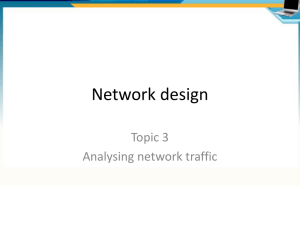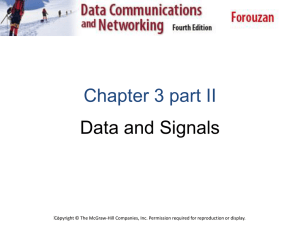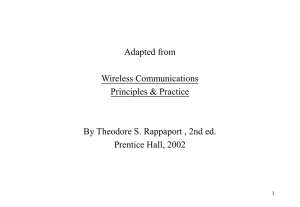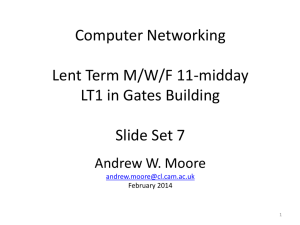A DiffServ Scheduling policy - Department of Systems and Computer
advertisement
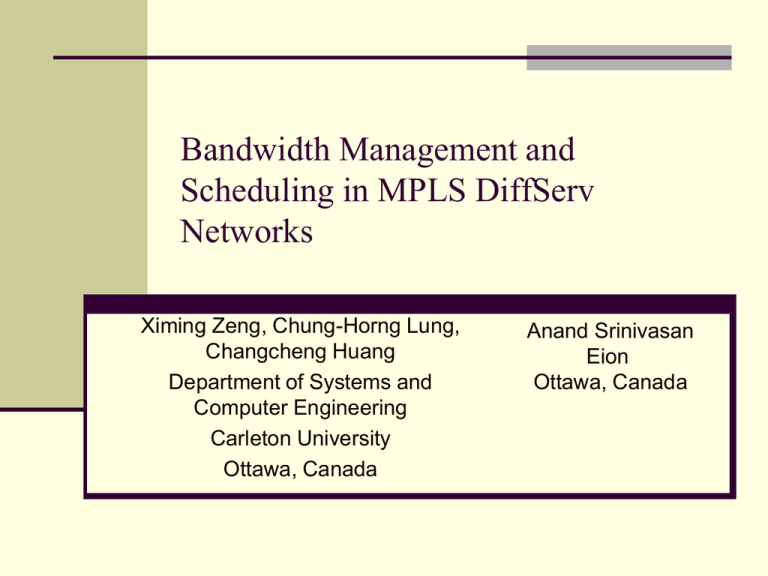
Bandwidth Management and Scheduling in MPLS DiffServ Networks Ximing Zeng, Chung-Horng Lung, Changcheng Huang Department of Systems and Computer Engineering Carleton University Ottawa, Canada Anand Srinivasan Eion Ottawa, Canada Outline Diverse QoS Requirements DiffServ Forwarding Classes Cisco Solutions Solutions based on fair queueing Our Solution Performance study QoS requirements Packet Loss 5% Conversational voice and video 0% Zero loss 100 msec Command / control (eg Telnet, Interactive games) Voice/video messaging 1 sec Transactions (eg E-commerce, Web-browsing, Email access) Streaming audio/video 10 sec Messaging, Downloads (eg FTP, still image) Delay Fax 100 sec Background (eg Usenet) QoS requirements for real time applications Medium Audio Application Conversational voice Degree of symmetry Two-way Typical Data rates/ Amount of Data 4 - 64 kb/s Key performance parameters and target values End-to-end One way Delay Delay Variation within a call Information Loss** <150 msec Preferred* < 1 msec < 3% Packet Loss Ratio <400 msec limit* Video Videophone Two-way 16 -384 kb/s < 150 msec preferred <400 msec limit Lip-synch : < 100 msec < 1% Packet Loss Ratio Data Telemetry - two-way control Two-way <28.8 kb/s < 250 msec N.A Zero Data Interactive games Two-way < 1 KB < 250 msec N.A Zero Data Telnet Two-way (asymmetric) < 1 KB < 250 msec N.A Zero QoS requirements for interactive applications Medium Application Degree of symmetry Typical data rate/ Amount of data Key performance parameters and target values One-way Delay (response time) Delay Variation Information loss Audio Voice Messaging Primarily one-way 4-32 kb/s < 1 sec for playback < 2 sec for record < 1 msec < 3% Packet Loss Ratio Data Web-browsing - HTML Primarily one-way ~ 10 kB < 4 sec /page N.A Zero Data Transaction services – high priority e.g. e-commerce, ATM Two-way < 10 kB < 4 sec N.A Zero Data E-mail (server access) Primarily One-way < 10 kB < 4 sec N.A Zero QoS requirements for streaming applications Medium Application Degree of symmetry Data rate/ Amount of data Key performance parameters and target values Start-up Delay Transport delay Variation Packet loss at session layer Audio Speech, mixed speech and music, medium and high quality music Primarily one-way 5-128 kb/s < 10 sec < 1 msec < 1% Packet loss ratio Video Movie clips, surveillance, realtime video Primarily one-way 16 -384 kb/s < 10 sec < 1 msec < 1% Packet loss ratio Data Bulk data transfer/retrieval, layout and Synchronisation information Primarily one-way 10 kB – 10 MB < 10 sec N.A Zero Data Still image Primarily one-way < 100 kB < 10 sec N.A Zero DiffServ Service Classes Expedited Forwarding (EF) PHB (RFC-2598) Provides a low-loss, low-latency, low-jitter, and assured bandwidth service. Real-time applications such as voice over IP (VoIP), video, and online trading programs require such a robust network-treatment. Assured Forwarding (AFxy) PHB (RFC-2597) Provides certain forwarding assurance by allocating certain bandwidth and buffer space. Applications with certain QoS requirements but not realtime can use AF service. For example: streaming video. Best Effort Service No service guarantee except for a minimum bandwidth to prevent service starvation. Cisco Solution LLQ or MDRR High priority EF Low priority AF and BE EF VoIP, Interactive Game… AF1x Video Conferencing… AF2x Video on demand … AF3x E-commerce … AF4x …… BE http,ftp, email… PQ CBWFQ Total reservable bandwidth is about 75%. BE reservation fixed around 25%. EF traffic is constrained and should not exceed 33%; small queue and packet size. AFs reserve the rest bandwidth. Cisco Solution BE = 25% EF<33% AF4 AF3 AF2 AF1 EF is assigned a bandwidth less than 33% of the link speed and is constrained according to the assigned bandwidth. However burst of EF traffic still exists. BE reserves a certain amount of bandwidth. The rest of the bandwidth can be allocated to AF services. AFs and BE may not always get their bandwidth as reserved ! Cisco Solution Advantage:EF packets are guaranteed smallest delay possible by given them high priority. Tradeoff: AF packets may be delayed due to burst of EF packets and cannot meet its desired delay bound! bytes bytes ρ delay delay backlog backlog σ r t t To minimize the impact EF brings to the AF classes: EF has small queue size (therefore, close to CBR) EF has small packet size (shorter waiting time for other packets) Cisco Solution What if the EF traffic is bursty? Link rate Peak rate Reserved rate Average rate EF traffic rate t AIftrade bandwidth off hasother to bethan made! the The average peak actual raterate of bandwidth EF of EF traffic traffic reserved is claimed is claimed toallocatable, EFallocatable, class should thenthen AF close whento QoS isEF guaranteed. the burst peakcomes, rateLow tothe minimize bandwidth bandwidth theutilization! service to AF classes impact.cannot be guaranteed. Bad QoS! Cisco Solution EF average BE=25% EF wasted AF4 AF3 AF1 AF2 Under LLQ, to minimize the service impact to AF service Classes, EF bandwidth is Over-provisioned. Other solutions Assign each class certain bandwidth EF VoIP, Interactive Game… AF1x Video Conferencing… AF2x Video on demand … AF3x E-commerce … AF4x …… BE http,ftp, email… WFQ/ DWRR Other solutions (WFQ) Use weighted fair queueing to assign bandwidth to EF, AF and BE classes. Advantage: Service to AF packets will not be affected by EF traffic, they always get their reserved bandwidth Disadvantage: Over-provisioning is still needed to guarantee small delay to EF classes. r delay delay σ ρ r If EF traffic is bursty, to have a small delay, a large bandwidth reservation is needed, which causes the same problem of wasted bandwidth. Other solutions (DWRR) Dynamically adjust the bandwidth to EF class according to the backlog of EF traffic. The unused bandwidth can be used by BE traffic. Advantage: the EF still gets a relatively low delay. Practical problems: 1)How often should we adjust the bandwidth allocation? 2)If it is WFQ, how can we adjust the virtual finish time for all the backlogged packets on line? 3)The bandwidth unused by EF can be used by BE, but is there any guaranteed minimum bandwidth? Or how can we assign the unused bandwidth? Our Solution Proposed scheduler architecture High priority EF VoIP, Interactive Game… Low priority BE http,ftp, email… AF1x Video Conferencing… AF2x Video on demand … AF3x E-commerce … AF4x …… PQ CBWFQ Our Solution EF and BE share the bandwidth: EF EF r max(ravg r BE , rres ) Link rate Peak rate Reserved rate rresEF BE traffic rate Average rate EF traffic rate t EF ravg Our Solution EF and BE share the bandwidth: EF EF r max(ravg r BE , rres ) Link rate BE traffic rate Peak rate EF r Reserved rate res Average rate r EF avg EF traffic rate t Our Solution EF + BE = EF rBE + ravg EF ravg rBE = 25% EF EF - ravg rres AF4 AF3 AF1 AF2 The pie under WFQ or Cisco LLQ Now free! AF4 AF3 AF1 AF2 The pie under our solution. You can have an extra slice! Our Solution Advantages: EF is given no less (if not more) bandwidth than in WFQ. Performance is guaranteed. AFs are guaranteed the same bandwidth, the same performance can be expected. Bandwidth can be allocated to EF and AF users more efficiently! Tradeoff: BE traffic may experience a longer delay due to EF bursts. However, they are not delay sensitive and their average minimum throughput is still guaranteed. Simulation result Src 0: EF traffic: 7 on-off voice sources 369 packets/sec in average. Src 1: BE traffic: 800 packets/sce, Exponential Src 2/3: AF traffic: 400 packets/sce, Exponential Link speed: 2000 packets/sce. Average load: 98.45% Simulation result EF delay under LLQ, DWRR and WPRR LLQ provides the smallest Delay to EF class. WPRR provides delay which is Comparable tp LLQ DWRR provides a much longer Delay. Simulation result AF delay under LLQ, DWRR and WPRR The same delay bound is Guaranteed under both DWRR And WPRR. Under LLQ, the AF delay is longer Due to the burstness of EF traffic. 6% of the packets violate the delay Bound. Simulation result BE throughput Simulation result BE throughput Conclusion We developed a new scheduler for DiffServ routers with the following advantage: High bandwidth utilization Guaranteed QoS Guarantee small delay and loss for EF. Provide QoS guarantee to AF by reserving the bandwidth. Guarantee the minimum throughput of BE. References [1] S.Blake, D.Black, M.Carlson, E.Davies, Z.Zhang, W.Weiss, “An Architecture for Differentiated Services.” IETF RFC 2475. Dec 1998. [2] V. Jacobson, K. Nichols, K. Poduri, “An Expedited Forwarding PHB.” IETF RFC 2598. June 1999. [3] J. Heinanen, F. Baker, W. Weiss, J.Wroclawski, “Assured Forwarding PHB Group.” IETF RFC 2597. June 1999. [4] J. Mao, W.M. Moh. B Wei, “PQWRR scheduling algorithm in supporting of DiffServ” 2001. ICC 2001. IEEE International Conference on Communications,Volume: 3 , Pages:679 – 684.11-14 June 2001. [5] A.K.Parekh, R.G.Gallager, “A Generalized Processor Sharing Approach to Flow Control in Integrated Service Networks: The single node case,” IEEE/ACM Transactions on Networking, Pages:344 - 357. June 1993. [6] H.Wang, C.Shen, K.G.Shin, “Adaptive-weighted packet scheduling for premium service” Communications, 2001. ICC 2001. IEEE International Conference on , Volume: 6 , Pages:1846 – 1850. 11-14 June 2001. [7] F. Le Faucheur, L. Wu, B. Davie, S. Davari, P. Vaananen, R.Krishnan, P. Cheval, J. Heinanen, “Multi-Protocol . Label Switching (MPLS) Support of Differentiated Services.” IETF RFC 3270 May 2002 Thank You !
